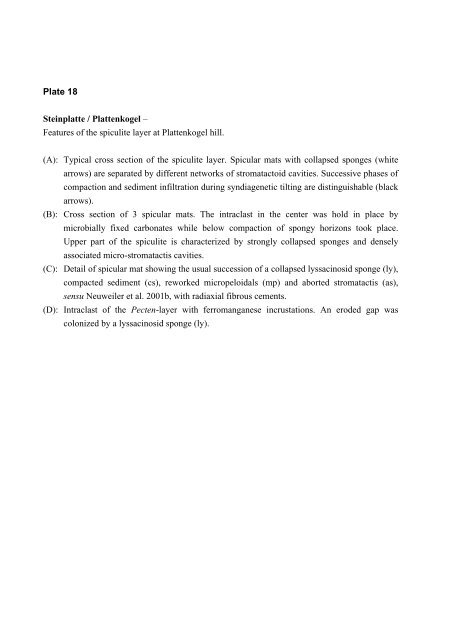Porifera-microbialites of the Lower Liassic (Northern Calcareous ...
Porifera-microbialites of the Lower Liassic (Northern Calcareous ...
Porifera-microbialites of the Lower Liassic (Northern Calcareous ...
You also want an ePaper? Increase the reach of your titles
YUMPU automatically turns print PDFs into web optimized ePapers that Google loves.
Plate 18<br />
Steinplatte / Plattenkogel –<br />
Features <strong>of</strong> <strong>the</strong> spiculite layer at Plattenkogel hill.<br />
(A): Typical cross section <strong>of</strong> <strong>the</strong> spiculite layer. Spicular mats with collapsed sponges (white<br />
arrows) are separated by different networks <strong>of</strong> stromatactoid cavities. Successive phases <strong>of</strong><br />
compaction and sediment infiltration during syndiagenetic tilting are distinguishable (black<br />
arrows).<br />
(B): Cross section <strong>of</strong> 3 spicular mats. The intraclast in <strong>the</strong> center was hold in place by<br />
microbially fixed carbonates while below compaction <strong>of</strong> spongy horizons took place.<br />
Upper part <strong>of</strong> <strong>the</strong> spiculite is characterized by strongly collapsed sponges and densely<br />
associated micro-stromatactis cavities.<br />
(C): Detail <strong>of</strong> spicular mat showing <strong>the</strong> usual succession <strong>of</strong> a collapsed lyssacinosid sponge (ly),<br />
compacted sediment (cs), reworked micropeloidals (mp) and aborted stromatactis (as),<br />
sensu Neuweiler et al. 2001b, with radiaxial fibrous cements.<br />
(D): Intraclast <strong>of</strong> <strong>the</strong> Pecten-layer with ferromanganese incrustations. An eroded gap was<br />
colonized by a lyssacinosid sponge (ly).

















